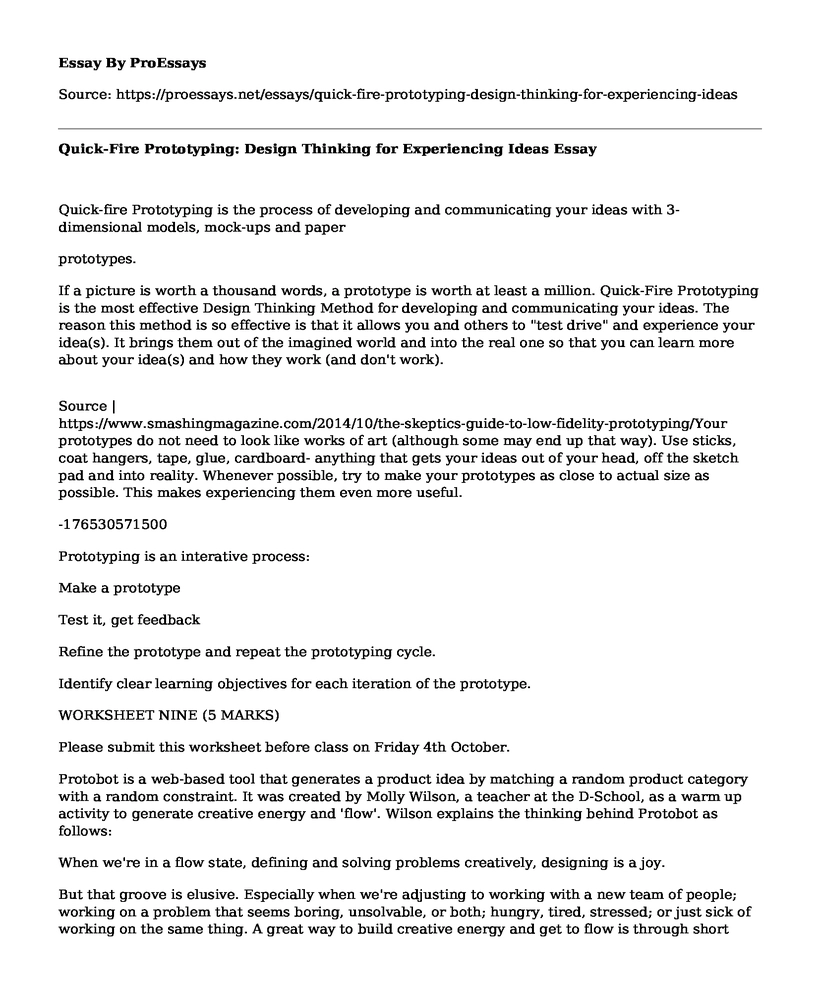Quick-fire Prototyping is the process of developing and communicating your ideas with 3-dimensional models, mock-ups and paper
prototypes.
If a picture is worth a thousand words, a prototype is worth at least a million. Quick-Fire Prototyping is the most effective Design Thinking Method for developing and communicating your ideas. The reason this method is so effective is that it allows you and others to "test drive" and experience your idea(s). It brings them out of the imagined world and into the real one so that you can learn more about your idea(s) and how they work (and don't work).
Source | https://www.smashingmagazine.com/2014/10/the-skeptics-guide-to-low-fidelity-prototyping/Your prototypes do not need to look like works of art (although some may end up that way). Use sticks, coat hangers, tape, glue, cardboard- anything that gets your ideas out of your head, off the sketch pad and into reality. Whenever possible, try to make your prototypes as close to actual size as possible. This makes experiencing them even more useful.
-176530571500
Prototyping is an interative process:
Make a prototype
Test it, get feedback
Refine the prototype and repeat the prototyping cycle.
Identify clear learning objectives for each iteration of the prototype.
WORKSHEET NINE (5 MARKS)
Please submit this worksheet before class on Friday 4th October.
Protobot is a web-based tool that generates a product idea by matching a random product category with a random constraint. It was created by Molly Wilson, a teacher at the D-School, as a warm up activity to generate creative energy and 'flow'. Wilson explains the thinking behind Protobot as follows:
When we're in a flow state, defining and solving problems creatively, designing is a joy.
But that groove is elusive. Especially when we're adjusting to working with a new team of people; working on a problem that seems boring, unsolvable, or both; hungry, tired, stressed; or just sick of working on the same thing. A great way to build creative energy and get to flow is through short bursts of structured exercises, or warm-ups, unrelated to our design problem. They're a breath of fresh air when we've been thinking along the same well-worn paths for hours, days, weeks. Designers and design thinking folks know this already. When we're running sprints or workshops, we borrow from improv theater, which brings a rich, deep set of games that give our brains a rest and a stretch at the same time (http://molly.is/writing/protobot/).
Go to the webpage http://protobot.org/#enYou will see a design challenge on this page that begins with the instruction 'Design a ...'
If you find the challenge too hard or uninspiring, hit the 'randomize' button until you get a challenge that captures your imagination. Now, grab some paper and pens and/or lego, playdough or any other materials you can work with quickly.
Set a timer for 3 minutes and sketch or make a prototype in response to the challenge that protobot has given you. Take a photo of your sketch/prototype.
Do this 3 times (making and documenting 3x 3-minute prototypes in response to the same protobot challenge).
Write the protobot challenge you were given below and paste the documentation of your three sketches/prototypes.
A camera that gives you goosebumps.- Making a 3600 video camera with raspberry pi.
Reflect on this activity. Last week's worksheet referred to the usefulness of constraints to drive creativity and innovation. The protobot activity uses the constraint of time.
Did you find having a time limit to be a useful creative constraint?
What other kinds of creative constraints are used in prototyping?
The time limit is useful constraints that created an innovation challenge. It created specificity in solving the customer issue. It created a time limit challenge hence a cheap and creative design of the 3600 video camera. The inclusion of the Raspberry Pi was to create a cheap video camera.
Other kinds of Constraints used in prototyping include innovation strategy constraint, experimentation constraints, implementation constraints. Innovation strategy constraints involve identification of the focus designed for the innovation process. Experimentation means risking the idea by testing with the customer. The implementation of restriction consists in triggering the constraints through regulating the launch budget.
Cite this page
Quick-Fire Prototyping: Design Thinking for Experiencing Ideas. (2023, Feb 20). Retrieved from https://proessays.net/essays/quick-fire-prototyping-design-thinking-for-experiencing-ideas
If you are the original author of this essay and no longer wish to have it published on the ProEssays website, please click below to request its removal:
- Grant Writing Guide Paper Example
- Movie Analysis Essay on Roots - The Triumph of an American Family
- The Three Major Steps in the Writing Process - Essay Sample
- Media and the Fashion World
- Research Proposal: Impact of Technology & Media on Society in the US
- Essay on Social Media Influencers: An Innovative Solution to Intangibility in Tourism Industry
- Essay Example on Global Fashion Industry







